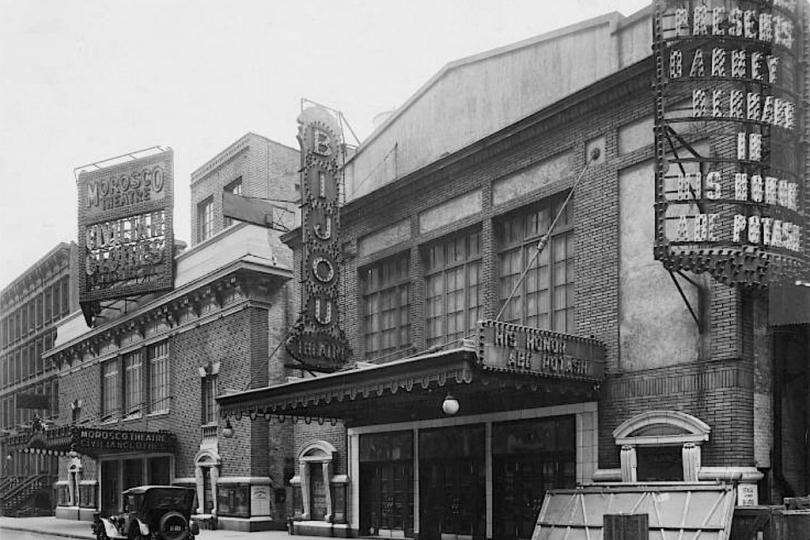Broadway Theaters Lost and Found

Christmas Day, 2011. The doors were unlocked, so I walked in and looked around. Fortunately, the rococo interior in red, gold and brown, with murals depicting the French nobility at play, 247 W. 51st Street, now the Times Square Church, opened in 1930 as the Hollywood Theater. Due to being landmarked, it still has its beautiful lobby with a three-story mirrored rotunda, and the owners have maintained respect for the theater’s design. Renamed the Mark Hellinger Theater after the critic and writer in 1949, I walked down to the stage, lined with poinsettias. An usher stood near me and I mused, “Just think, Rex Harrison and Julie Andrews played My Fair Lady on this stage, Katharine Hepburn played Coco Chanel here and Angela Lansbury was The Madwoman of Chaillot here. Not to mention Ann Miller and Mickey Rooney in Sugar Babies!” She replied by telling me that Reverend So and So had also preached from here. I shook my head and replied, “It’s not the same thing.” I thanked her, took one more look at this gorgeous theater and continued on my way.
Perhaps someday, the Mark Hellinger will return.
Once there were 85 theaters in Manhattan, and the theater district was 25 blocks from 38th Street to 63rd Street. It hasn’t changed that much, although 43 of these buildings are gone, either from foreclosure or demolition or both. 41 theaters, now located between 41st and 65th Streets, light the Great White Way, one of them recently opened for the first time since 1968.
First, come corrections: There are only 4 theaters located on Broadway (Winter Garden, Broadway, Marquis and Vivian Beaumont), and only two of them (The Broadway and the Winter Garden) have entrances on the street itself. The Marquis did have a Broadway entrance, but when the Marriott Hotel was renovated, the entrance moved to the alley between 45th and 46th Streets. The Vivian Beaumont faces Broadway, but it’s tucked in the northwest corner of Lincoln Center Plaza. Something else about the Beaumont: it also houses the Mitzi Newhouse Theater, an Off-Broadway house.
How can this be? If it’s located on Broadway, it’s a Broadway house, right? Not necessarily. Most of the theaters are on side streets and a Broadway house isn’t determined by location, but by seating capacity. Anything less than 500 seats is Off-Broadway. In fact, two of Off-Broadway’s longest running hits, Perfect Crime and The Fantasticks are playing in the Snapple Center, with an entrance on the corner of 50th and Broadway. (The Fantasticks is due to close this Spring.) Stories of how several theaters have changed are listed below:
From a Broadway to an Off-Broadway House
Theatre Republic at 207 W. 42nd Street, was built by Oscar Hammerstein (the lyricist’s father) in 1900 and managed by producer/playwright David Belasco (Madame Butterfly). Labeled a “parlor theater,” the Republic included a double marble staircase that led to a balcony with its own box office. The color scheme was green, ivory and gold, and there was a gilded dome over the auditorium with a chandelier copied from the U.S. Capital. Belasco added the first trap doors, elevator lifts and turntables to a New York theater.
A tradition was established here after finding a lucky horseshoe backstage. It was hung over the stage door and Abbie’s Irish Rose became one of the first hits at the Republic. The horseshoe was removed when the show closed, but the tradition continued. In 1931, Billy Minsky took over and presented Burlesque for 11 years. Of course, their greatest attraction was the legendary Gypsy Rose Lee, known mostly today because she’s the topic for Gypsy, one of the greatest of American musicals.
During the War, the theater was renamed the Victory, and showed movies, but by the early 1970s, like many of the theaters in Times Square, it was reduced to porn. The 1990s brought renewal to 42nd Street, so renovated and refurbished with 500 seats, The New Victory became a home for children’s theater and family-oriented entertainment.
A Home for Spectacle
The Lyric Theater, 213 W. 42nd Street, next to the New Victory, was built in 1903, and with 1200 seats, quickly housed operettas and light musicals. Its decor featured ivory and gold plaster reliefs surrounding the ceiling of white stone. An iron and glass canopy opened to the auditorium and the stairs to upper level rehearsal rooms. The Marx Brothers played their first smash hit, The Cocoanuts here. Turned into a movie theater in 1934, it began to deteriorate. In 1996, renovations began. Combined with its neighbor, the Apollo, the capacity was raised to 1800, and in January 1998, as the Ford Center for the Performing Arts, it opened with Ragtime. Its most recent resident was Cirque de Soliel, but in 2018, it will house Harry Potter and the Cursed Child. In the 19 years since it opened, this theater has had three name changes: From the Ford, it became the Hilton, then the Foxwoods and finally, it’s returned to its original name, the Lyric.
The most beautiful theater on Broadway
Built in 1903, The New Amsterdam Theater, 214 W. 42nd Street, was and is, along with the Schubert on W. 44th Street, the most beautiful theater on Broadway. With its art nouveau style, elaborate stone carvings, flowered scrolls, curved windows crowned with medieval images of knights, maidens and the muses of comedy, drama and music, artistic panels covered the walls, and elaborate grill work covered the domes in the restroom lobby. Opening with productions of Shakespeare and operettas, in 1913 it was taken over by impresario Florenz Ziegfeld, who staged nine of his Follies here, and opened another theater on the roof, where his Frolics played. It later became a movie theater, and in 1982 was landmarked. Louis Malle’s film Vanya on 42nd Street was shot in the wreckage of the theater, but when Disney looked to establish a beachhead on Broadway, this was the ideal spot. A very expensive renovation occurred, beautifully documented in the book, The New Amsterdam, Biography of a Broadway Theater, and it opened with The Lion King in 1998. After a decade, that show moved to the Minskoff to make way for Mary Poppins. It’s now the home of Aladdin.
From Drag to Multiplex
The Eltinge, 236 W. 42nd Street, opened in 1912 and was named for Julian Eltinge, a renowned drag performer of the era. The theater is featured in Buster Keaton’s film, Seven Chances, when, Keaton is given 24 hours to find a wife or lose an inheritance. Keaton enters the stage door, only to leave with a hand over his cheek, evidently slapped by Eltinge after a proposal. Its impressive façade, featuring a large window of paned glass, is decorated with terra-cotta ornaments in green, blue, orange and red. The theater originally featured Egyptian motifs with Greek and Roman figures.
Over time, the Eltinge housed Burlesque, but during the 1990s, the landmarked façade and lobby mural were saved and moved 100 feet east. Julian Eltinge has been forgotten, but the newly constructed building behind the façade houses the AMC Empire 25 theater multiplex. It’s a bittersweet thrill to stand in the lobby, look up at the recreated mural and consider what a glorious theater this must have been.
The Roundabout Theater Company
The Selwyn Theater, 229 W. 42nd Street, was built in 1918 with an impressive 100-foot lobby, and a stark brick façade. The auditorium was done in the Italian Renaissance style, with walls of gold and blue, five murals, and deep blue fabric for its curtains and upholstery. The opening production was Information Please by Jane Cowl, which lasted 8 weeks. Over the years, musicals, revues, comedy and drama have played here, with The Royal Family and Andre Charlot’s Revue of 1924 starring Gertrude Lawrence among its attractions. It remained open as a film revival house and in 1990, renamed the American Airlines Theater, it became the flagship theater for the Roundabout Theater Company, which presents three revivals yearly, among the most recent Long Day’s Journey Into Night, for which Jessica Lange won a Tony Award.
Henry Miller’s Theater, 124 W. 43rd Street, opened in 1918. Designed in an American colonial style, with English garden designs there were three glass entrances with an oval box office and a bright blue foyer. The auditorium, designed for comfort, featured antique gray walls and a large chandelier. Brocaded hangings and seat fabrics matched. The theater has had quite a history, too. It housed legitimate theater for 50 years, after which it showed blue movies as the Park-Miller. It became a nightclub called Xenon. As the Kit Kat Klub, the first Roundabout revival of Cabaret opened here before moving to Studio 54. Following the Broadway run of Urinetown, the façade was saved, while the theater was completely rebuilt. Now named after Stephen Sondheim, the Roundabout used it for revivals of Bye, Bye, Birdie, Anything Goes and The Trip to Bountiful. Beautiful, the current resident is The Carole King Musical. The new building resembles London theaters with its orchestra level underground and the balcony at street level. Items from the original building have been saved and are displayed. Except for a concert of his music, nothing by its namesake has played this theater.
The history of the Gallo Opera House, 254 W. 54th Street, is also legendary. Built in 1927, it has an unassuming façade, but a lobby lined with mirrors and crystal chandeliers giving it the look of an elegant promenade. Italian Renaissance highlights in gold and rose complement bronze brown walls accented in dull blue. In 1933, entrepreneur Billy Rose turned it into a casino, after which the Federal Theater Project used it. CBS broadcast game shows from here until 1975. It later opened as the storied nightclub, Studio 54. The Roundabout moved Cabaret here, and it’s now a flexible theater space that hosts open-ended engagements of plays and musicals.
An old new theater
The fate of the Hudson Theater, 141 W. 44th Street, is the most exciting recent news of Broadway. Built in 1903 by Henry Harris (who was lost on the Titanic), it was designed with a renaissance façade and a lobby of Greco-Roman motifs with Tiffany glass in green, orange and ivory. Tiffany glass mosaics decorate its triple domed ceiling. After 30 years of theater, CBS transformed it into a radio studio. It later returned to legitimate theater and such classics as Arsenic and Old Lace, Detective Story and State of the Union played the Hudson. Following stints as a TV studio, nightclub and conference center, after 49 years, it’s recently been renovated by London’s Ambassador Theater Group and is being used for theater again. A concert theater version of Sunday in the Park with George starring Jake Gyllenhaal opened the new venue and will play through April. It will be followed by 1984, a play based on George Orwell’s novel.
The Sad Fate of Five Theaters
In the early 80s, architect John Perlman, Jr. bought the Bijou, Helen Hayes, Morosco, as well as the remnants of the Astor and Gaiety theaters. Their fate launched the Save the Theaters Campaign. Even as protesters went to jail, the wrecking ball swung, leaving only the 46th Street Theater, now the Richard Rodgers and home of Hamilton. In its place, The Marquis Theater, which the theater community considers a “monstrosity,” sits on the second floor of a Marriott Hotel. New York leaving only memories of these gems:
Opened in 1917, The Bijou Theater, 209 W. 45th Street, had a small lobby and an auditorium of blue, ivory, grey and gold in the style of Louis XVI, because it was intended to house French Theater. Its debut production, The Knife, lasted 10 week with limited fare until the late 1930s, when it was converted into a movie theater. In 1943, Life with Father, still the all-time longest-running Broadway play transferred here. In 1959, its neighboring theaters needed more lobby space, so the Bijou grew smaller. In the late 1970s, the Bijou was just right for the brilliant Swiss production, Mummenschanz, which played for three years, but after that, the empty theater awaited demolition by Perlman.
The Morosco Theater, 217 W. 45th Street, 1917. Knowing my fascination with Broadway theater architecture, a friend of mine and I often compared notes. When I asked her what her favorite theater was, she answered The Morosco. This simple building highlighted by a small marble lobby (later expanded), had bronze doors, with furnishings, carpets and drapes done in violet contrasted by grey walls. The Morosco was home to such classics as Arthur Miller’s Death of a Salesman, Tennessee Williams’ Cat on a Hot Tin Roof, the 1973 revival of O’Neill’s A Moon for the Misbegotten and Side by Side by Sondheim. It was destroyed in 1982.
Folies-Bergere, 210 W. 46th Street, opened in 1911 and was intended as a dinner theater. A bronze cornice appeared on the terra-cotta façade. Turquoise blue, ivory and gold Venetian tiles surrounded a Folies-Bergere relief. The orchestra seats were terraced, decorated in soft rose, pearl gray and gold, and featured pink shaded candelabras. The proscenium arch was crowned with trumpeting angels. Among its early attractions, Bela Lugosi scared audiences as Dracula, and in 1955 the “first lady of the American Theater,” Helen Hayes, was honored to have the theater named for her. Later hits were the premiere production of Eugene O’Neill’s Long Day’s Journey into Night. Following its demolition, the Little Theater on 44th Street was renamed for Helen Hayes.
The Astor had long been closed, and the Gaiety had become a movie theater. Theatergoers will never again glimpse the glories of these auditoria, but, thankfully, due to being landmarked, this will never happen again.
Across 7th Avenue, in the midst of 48th Street, the Playhouse Theater, opened in 1911 and featured stone carvings of comedy and tragedy on its façade. Its oak doors featured diamond glass and the house was designed to bring audiences closer to the stage, dressed in deep red and gold, with blue drapes and brown carpets. The home of such classics as Street Scene, Three Men on a Horse, The Miracle Worker and the premiere of The Glass Menagerie before its demise, the exterior of the Playhouse was featured in a pair of movies. In Valley of the Dolls, Neely O’Hara’s (Patty Duke) return to Broadway, Tell Me Darling, is playing here. More famously, the Springtime for Hitler number in the 1968 version of The Producers was filmed here.
With so many recent changes to the Theater District other theaters are being refurbished: The Belasco, Longacre and Friedman (formerly the Biltmore) have been updated. One theater needs serious renovations, and that’s the Music Box. Irving Berlin’s theater is very uncomfortable. People were smaller in the 1920s, because there’s no leg room in the Orchestra, and it only gets better further back in the Mezzanine. Nonetheless, the history of Broadway Theaters is the history of 20th Century American Theater.




